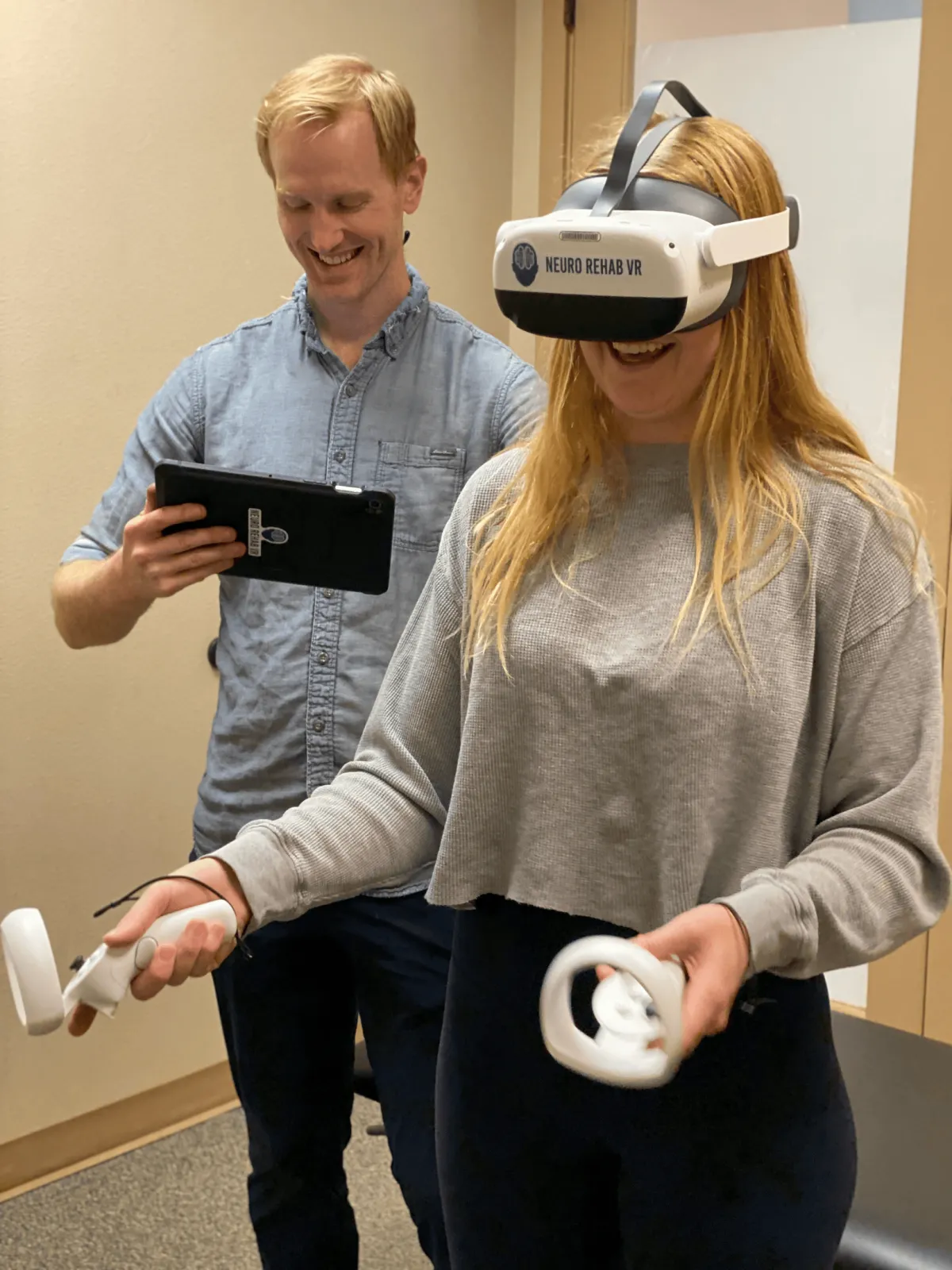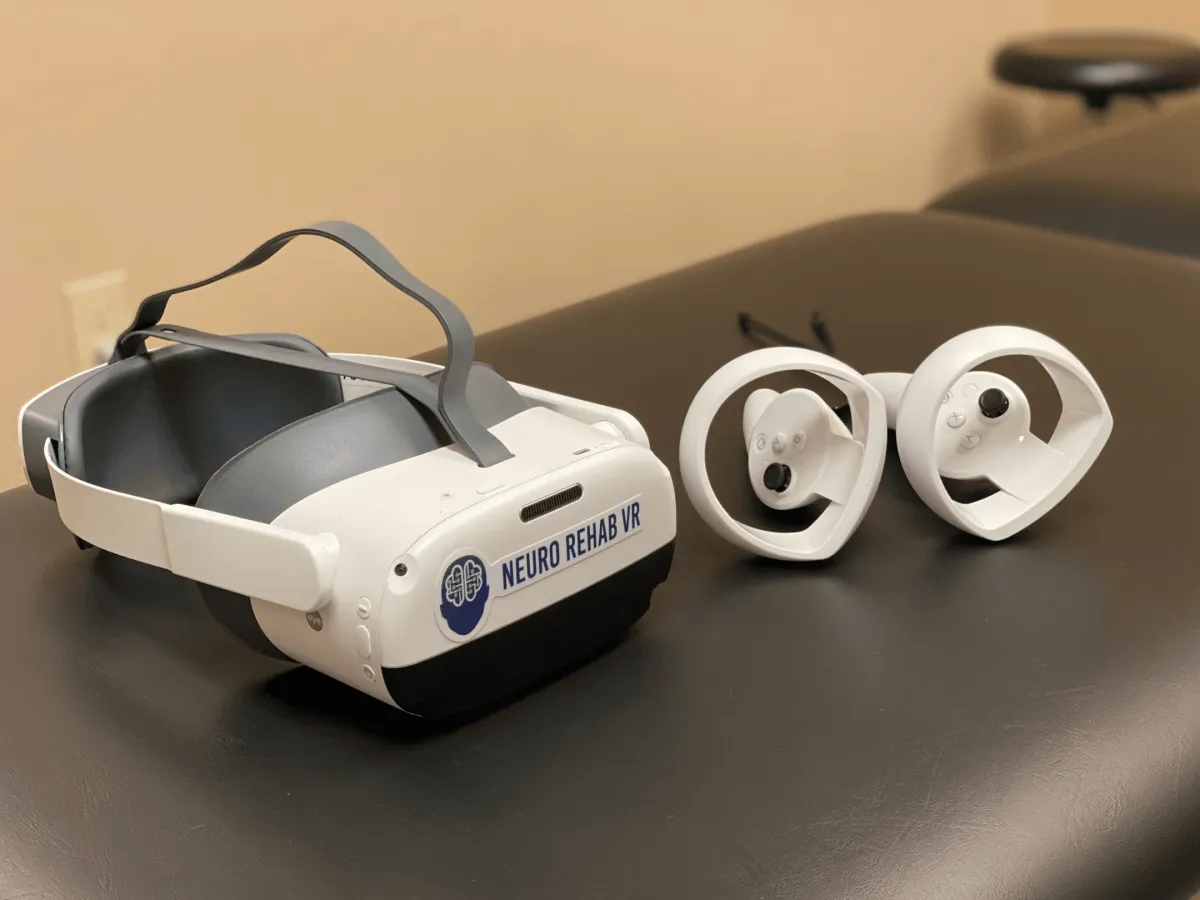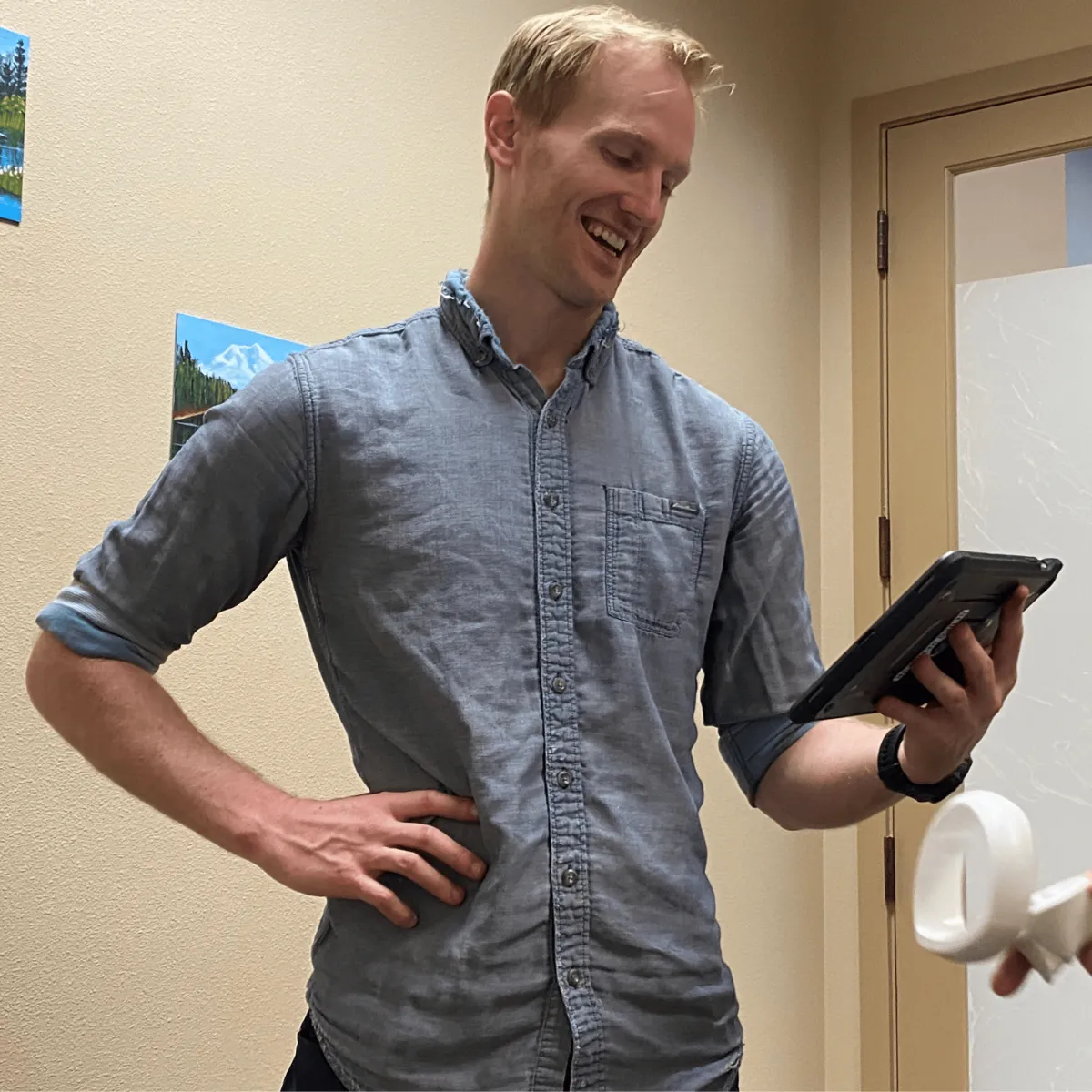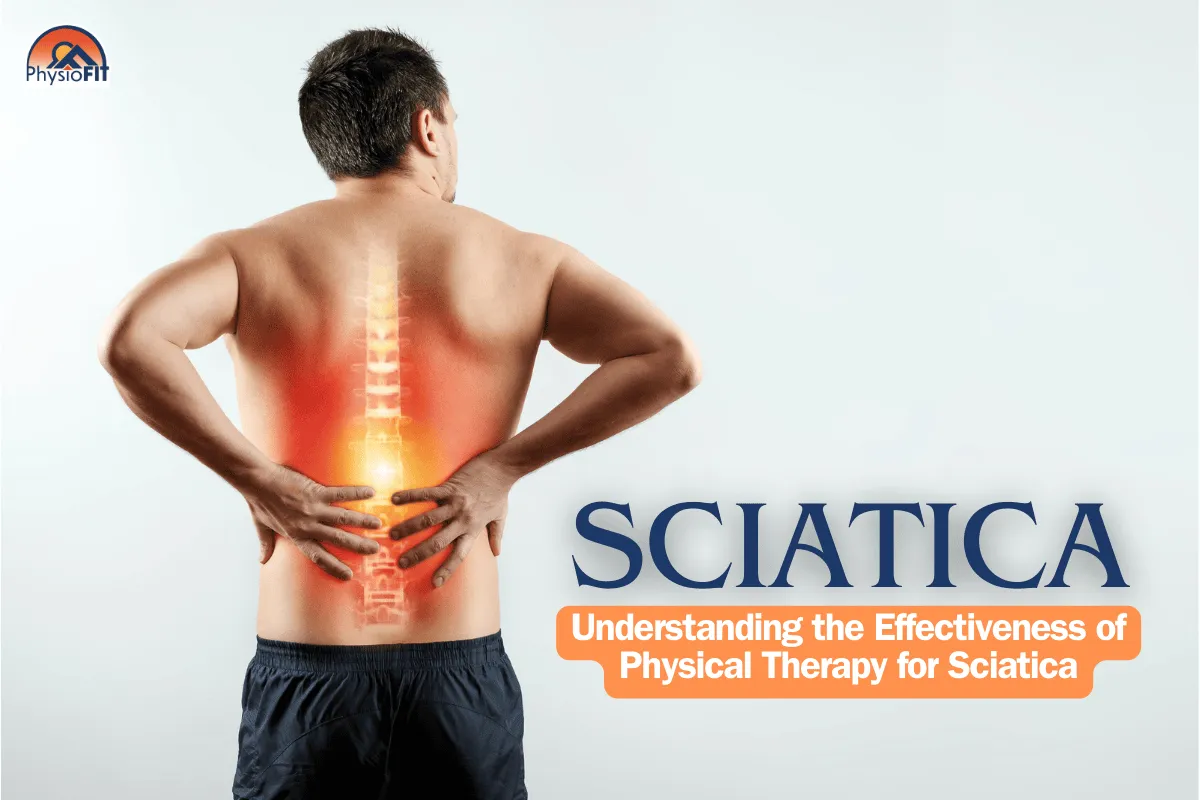Virtual Reality Physical Therapy
Virtual Reality Physical Therapy: A New Era of Healing at PhysioFIT
At PhysioFIT, we believe in embracing the latest advancements in physical therapy to provide our clients with unparalleled care. Our Virtual Reality Physical Therapy program is at the forefront of this innovative approach, blending cutting-edge technology with the expert guidance of Tanner Sommers, PT, DPT. This immersive experience not only enhances the healing process but also brings a level of engagement and precision to rehabilitation that was once unimaginable.

The Advantages of VR Physical Therapy
Immersive Engagement: With VR, you're not just doing exercises; you're playing games designed to help you heal, making the time fly by.
Precise Rehab Exercises: VR allows for pinpoint accuracy in therapy, helping to ensure each movement is contributing to your recovery.
Motivating Feedback: Instant feedback from the VR system encourages you to keep going, showing you how far you've come and where you're headed.
Customized Therapy Environments: VR can simulate environments and scenarios tailored to the patient's therapy goals, allowing for a customized experience that can adapt to their progress and preferences.
Enhanced Cognitive Engagement: By stimulating both the body and mind, VR therapy can help improve cognitive functions alongside physical abilities, leading to a more comprehensive rehabilitation process.
How Does Virtual Reality Physical Therapy Work?
Virtual Reality (VR) Therapy at PhysioFIT operates on the foundational concept of neuroplasticity—the brain's remarkable ability to reorganize itself by forming new neural connections throughout life. This ability is harnessed through repetitive practice and stimulation. Here's how our system takes advantage of this principle to aid in rehabilitation:
Multisensory Stimulation: Our VR system engages multiple senses simultaneously. By stimulating the vestibular system (which deals with balance), vision, proprioception (the awareness of body position and movement), cognitive functions through multitasking, and providing both haptic (touch) and auditory feedback, the therapy creates a rich environment for the brain to build new pathways. This multisensory approach is key to creating a robust and effective rehabilitation experience.
Task-Specific Training: The VR programs at PhysioFIT are designed to support task-specific training. This means the activities and games within the VR environment are tailored to help patients regain skills and abilities relevant to their daily life, work, or recreational activities. Whether it's returning to a sport or just the ability to perform daily tasks, the VR training is focused on practical and meaningful outcomes.
Customized Therapy Sessions: Our therapists, equipped with in-depth knowledge and tools provided by the VR system, have the capability to control and customize each aspect of the user experience. They ensure that each session is not only effective but also meets the specific challenges and therapy goals of the patient. This customization is critical to providing a session that is both beneficial and engaging for the patient.
Artificial Intelligence and Machine Learning: Neuro Rehab VR's system incorporates advanced technologies such as artificial intelligence (AI) and machine learning (ML) within its games and exercises. These technologies enable the system to automatically adjust to the patient's level of ability and progress. As the patient interacts with the system, AI algorithms analyze performance and dynamically adapt the difficulty and type of exercises in real-time. This ensures that patients are constantly challenged at an appropriate level for their current abilities, promoting optimal recovery and engagement.
The Power of Neuroplasticity: By utilizing VR therapy, we're tapping into the brain's plasticity to make recovery from injury a more dynamic and accelerated process. The goal is to create an environment where the patient can repeatedly perform targeted movements and tasks, leading to stronger neural connections and, ultimately, better motor function.
In essence, the VR therapy system at PhysioFIT is not just a set of exercises; it's a sophisticated, adaptable, and personalized therapy tool designed to engage the brain's natural ability to heal and adapt, ensuring that each patient can achieve the best possible outcomes in their rehabilitation journey.
Neuro Rehab VR: Our Technology Partner
Our partnership with Neuro Rehab VR, a Texas-based trailblazer in VR therapy solutions, enables us to offer the most advanced VR therapy system available.
Neuro Rehab VR's XR Therapy System is a clinically validated and FDA-registered platform that transforms patient care through immersive games and activities tailored to each patient’s therapy plan. The system includes:

Latest Technology: The XR Therapy System revolutionizes the therapeutic experience with state-of-the-art VR equipment, including headsets, controllers, and a specialized tablet for seamless control and interaction.
Comprehensive Care: Therapists can provide immersive and adaptive care with customized games and activities that cater to each patient's specific needs and abilities.
Data-Driven Results: A proprietary Data Analytics Portal allows for the measurement, tracking, and quantification of patient progress, ensuring targeted and efficient therapy outcomes.
Neuro Rehab VR has distinguished itself through extensive research and development, resulting in over 30 different activities and use cases ranging from stroke recovery to balance enhancement. The versatility of their system supports a wide demographic, including neuro rehab, orthopedics, geriatrics, and pediatrics, backed by over three decades of research confirming the effectiveness of VR in various aspects of rehabilitation
.
The XR Therapy System is celebrated for its ease of integration into clinical workflows, making it a turn-key solution for modern physical therapy practices. With its comprehensive design, therapists at PhysioFIT can control and guide the patient experience with a companion tablet, while also utilizing robust data analytics to track and quantify each patient's progress.
Furthermore, Neuro Rehab VR has garnered significant acclaim, including press coverage and industry accolades, for their innovation and contributions to healthcare technology. Their presence extends across various healthcare facilities in the U.S., from hospitals and outpatient clinics to senior living facilities, demonstrating their system's wide acceptance and success

Meet Tanner Sommers, PT, DPT - Your Virtual Reality Expert
Tanner Sommers is a leading physical therapist at PhysioFIT who expertly combines his extensive education in Exercise Science and Physical Therapy with advanced certifications in EMG/NCV and Level III dry needling. His innovative approach to rehabilitation is highlighted by his leadership in Virtual Reality Physical Therapy, utilizing Neuro Rehab VR's pioneering technology.
Certified in VR rehabilitation, Tanner is adept at creating immersive, personalized therapy sessions that prioritize patient engagement and holistic recovery. His commitment to integrating the latest in therapeutic innovation with compassionate care ensures that every patient is on a path to regain their fullest potential, making PhysioFIT a hub for forward-thinking physical therapy in Bend.
Please Note: The information provided on our website is intended for general education and is not a substitute for professional medical advice. Each individual's situation and body is different. Therefore, what may work for one person may not work for another. We care about your well-being and advise you to reach out to us to discuss your specific needs before implementing any advice from our website.
Your Source for All Things Physical Therapy in Bend Oregon
The PhysioBlog

Can Physical Therapy Help Sciatica: Understanding the Effectiveness of Physical Therapy for Sciatica
Please Note: The information provided on our website is intended for general education and is not a substitute for professional medical advice. Each individual's situation and body are different. Therefore, what may work for one person may not work for another. We care about your well-being and advise you to reach out to us to discuss your specific needs before implementing any advice from our website. If you’d like to explore this more or would like to schedule a time with a physical therapist in Bend Oregon, contact us at PhysioFITBend.com
Introduction
Imagine a pain that starts in your lower back and shoots down to your legs, making everyday activities a challenge. This is most often times, sciatica, a common yet often misunderstood condition. But there's hope. Physical therapy has emerged as a beacon of relief for those suffering from this debilitating ailment. In this comprehensive article, we'll explore the symptoms and impact of sciatica, delve into the efficacy of physical therapy, examine the types of therapy available, and discuss their success rates.
What is Sciatica and How Does it Affect You?
Sciatica is not your typical backache. It's a condition characterized by pain that originates in the lower back or buttock and travels down one or both legs. This pain is caused by irritation or compression of the sciatic nerve, the longest nerve in the body. Sciatica's pain is often described as sharp, burning, or even akin to an electric shock. It can vary in intensity and may be aggravated by sitting, standing for long periods, or certain movements.
Besides pain, sciatica can cause numbness, tingling, or muscle weakness in the affected leg or foot. Sometimes, these sensations can be as debilitating as the pain itself, making it difficult to walk or even stand.
The root causes of sciatica are diverse. A herniated or slipped disc, where the soft cushion of tissue between the bones in your spine pushes out, is a common cause. Spinal stenosis, the narrowing of spaces within your spine, can also put pressure on the nerves. Piriformis syndrome, where the piriformis muscle irritates the sciatic nerve, is another cause. Other factors like pregnancy, obesity, and prolonged sitting can increase the risk or exacerbate the symptoms of sciatica.
Neglecting sciatica can lead to worsening symptoms, chronic pain, and even permanent nerve damage. It's essential to seek timely treatment to prevent the progression of the condition and to maintain a good quality of life.
Physical Therapy for Sciatica: An Overview
Physical therapy stands as a beacon of hope for those suffering from sciatica. This non-invasive, medication-free approach is centered around relieving the symptoms of sciatica and addressing its root causes. Physical therapists use a variety of techniques tailored to each individual's condition.
Exercises aimed at strengthening the back and abdominal muscles play a crucial role in stabilizing the spine and alleviating pressure on the sciatic nerve. Flexibility exercises and stretches help improve the range of motion and reduce stiffness, further easing sciatic pain.
Nerve glides or neural mobilization exercises are particularly effective for sciatica. These exercises gently stretch and glide the sciatic nerve, helping to reduce nerve entrapment and improve nerve function.
Manual therapy, including massage and joint mobilization, can be instrumental in reducing nerve impingement by realigning the spine and relieving pressure on the sciatic nerve.
Efficacy of Physical Therapy: Is it Worth it for Sciatica?
When compared with other treatments like medication, injections, or surgery, physical therapy offers a unique advantage. It not only provides immediate pain relief but also works on the underlying causes of sciatica. Our approach here at PhysioFIT helps in reducing the recurrence of the condition and promotes long-term health of the spine and nervous system.
How Long Does Physical Therapy Take to Help Sciatica?
The journey to relief from sciatica through physical therapy can vary from person to person. Factors such as the severity of the condition, the specific cause of sciatica, and individual healing rates influence the recovery time. Generally, patients begin to experience relief within a few weeks of consistent physical therapy. However, achieving full recovery may take a longer period, depending on the individual's response to therapy and adherence to the prescribed exercise regimen. It’s important to find the proper physical therapist that can help with this. So be sure to contact us at our Bend location to make an appointment today!
What Therapy is Best for Sciatica?
Selecting the appropriate physical therapy technique is crucial and depends largely on the individual's specific condition and symptoms. For some, strengthening exercises may provide the most benefit, while others might find more relief through nerve glides or manual therapies. This decision is typically made following a comprehensive assessment by a skilled physical therapist.
The Success Rate of Physical Therapy for Sciatica
The success of physical therapy in treating sciatica is well-documented. Numerous studies and patient reports indicate substantial improvement in pain and functionality. Many patients are able to return to their daily activities without the debilitating pain that sciatica can cause.
Incorporating Physical Therapy into Your Sciatica Treatment Plan
Incorporating physical therapy into a treatment plan for sciatica begins with an assessment by a physical therapist. This assessment helps in creating a personalized treatment plan, which may include exercises, manual therapy, and education on posture and ergonomics. Regular sessions and at-home exercises are key components of this plan, and adjustments are made as needed to ensure continued progress and relief.
Conclusion
Physical therapy in Bend Oregon emerges as a highly effective, safe, and non-invasive treatment option for sciatica. By addressing both the symptoms and the root causes of the condition, physical therapy not only alleviates pain but also contributes to long-term spinal health. For those suffering from sciatica, physical therapy presents a viable path to recovery and a return to a pain-free life. So be sure to reach out today to make an appointment with us here at PhysioFIT.
FAQ Section
How often should I attend physical therapy sessions for sciatica?
The frequency depends on the severity of the condition. Typically, 2-3 times per week is recommended.
Can I do physical therapy exercises at home for sciatica?
Yes, home exercises are an important part of the treatment plan, but get guidance from your physical therapist first.
What lifestyle changes can support physical therapy for sciatica?
Maintaining a healthy weight, regular exercise, and proper ergonomics at work can help.
Are there any side effects of physical therapy for sciatica?
Physical therapy is generally safe with minimal side effects, but some discomfort may be experienced initially.
How do I know if physical therapy is working for my sciatica?
Reduction in pain and improvement in mobility are good indicators of progress.
Please Note: It's important to note that any exercises or techniques that are shared should be performed under the guidance of a qualified physical therapy expert to ensure correct technique and to prevent injuries. A physical therapist can provide a customized exercise program based on the individual's fitness level, goals, and any existing injuries or conditions. If you’d like to explore this more or would like to schedule a time with a physical therapist in Bend Oregon, contact us at PhysioFITBend.com
Copyright PhysioFIT 2023 . All rights reserved


